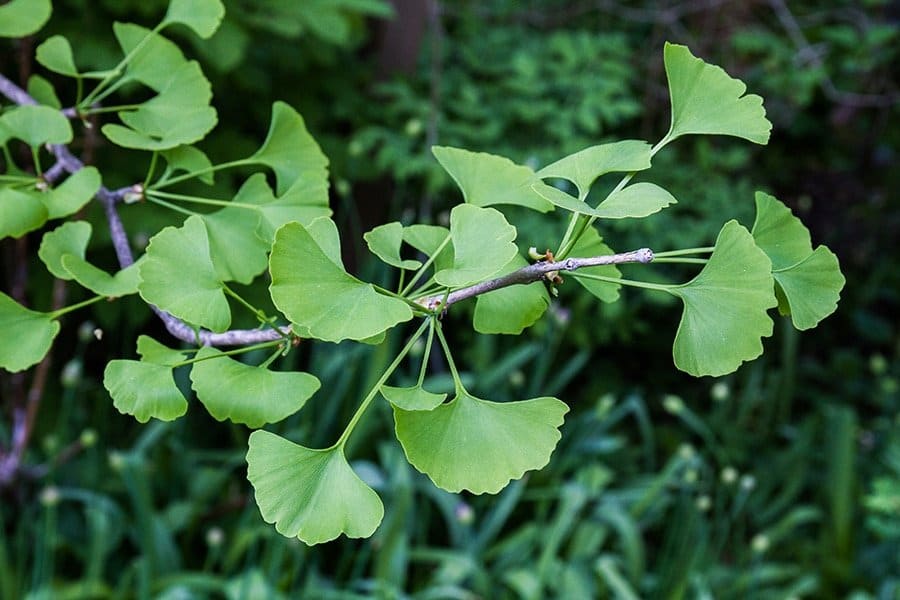
It’s hard to resist starting plant collections. If you’ve been gardening for a while, it’s only natural to develop favourite plants, and then to be curious about variations of those plants. I did this with Japanese maples, redbuds, beech trees and now I’m getting started with ginkgos (Ginkgo biloba, Zone 4). Considering that ginkgo trees have been around for more than 150 million years, was there ever a more dependable and useful tree?
Ginkgos are stunningly architectural, with widely spaced branches covered with delicate fan-shaped foliage and striped bark at maturity. They’re disease resistant and drought hardy, cast little shade, and their economical branching structure allows them to share tight space with other plants or act as a focal point in a small garden, shrub border or perennial bed. The open branches of my largest ginkgo supports a climbing ‘Clair Matin’ rose, and they make pretty companions.
One of the two ginkgos I have was purchased as a large landscape specimen and grows in a sunny shrub border; the other is from a rooted twig and grows in part shade between houses. Both have grown steadily and never had a problem. In the fall, their foliage turns deep lemon yellow, making a splendid display next to scarlet Japanese maples.
Book and Internet research quickly turns up at least 200 ginkgo variations. ‘Mayfield’ and ‘Barabits’ Fastigiata’ are tall and narrow, like a Lombardy poplar. ‘Weeping Wonder’ has leaves so finely dissected they appear shredded and ‘Golden Globe’ has a broad rounded form. Dwarf ‘Jade Butterflies’ and ‘Munchkin’ grow two to four feet (60 to 120 cm) tall with one-inch (2.5-cm) leaves. For colour and branching variation, ‘DJ’s Bow Tie’ has branches that are completely horizontal with almost blue leaves deeply divided in the centre like a bow tie. There are several variegated specimens like ‘Sunstream’ and ‘Majestic Butterfly’ with prominent yellow striping from the centre of the leaf outward.
These are all tree-form cultivars, and I was quite pleased on a recent visit to Mori Gardens and Garden Design Centre in Niagara-on-the-Lake, Ont., to find ‘Beijing Gold’, a shrub-form variegated ginkgo that grows 12 feet (3.5 m) tall and wide. ‘Beijing Gold’ might be the only shrub form known, as I haven’t seen any others listed. The spring foliage is yellowish chartreuse, and in summer will turn to green with gold striping, and then to deep yellow in fall. My specimen is about 40 inches (1 m) tall, and already branching out to an interesting form. Ginkgos grow quickly when adequately irrigated, so I’m looking forward to seeing some growth changes over this summer. ‘Beijing Gold’ is going to have a spot in full sun where a beech tree was taken out, and I expect the leaf colour will be bold.
There are just so many ways to use ginkgo trees — lining a driveway, making a tall hedge, centring a bed of summer annuals. I could go on! You might have read that ginkgo trees have undesirable fruiting characteristics, but that shouldn’t be a problem. Female ginkgo have foul-smelling fruit and aren’t available in commerce. Nursery-produced specimens are all male, and won’t bear fruit. This is one instance where the guys are the sweetest smelling.

Hello. I use Riley’s Garden Center in Kingston, Ontario. I bought an ‘Elegans’ Porcelain Ivy there. I don’t usually need to do research if I’ve bought from them. I was showing my husband what the plant looks like from an online photo and was shocked to discover it is considered invasive in the USA. I phoned Riley’s to ask and they said no, it’s fine to plant here. I trust your experience because I’ve purchased your books and I read your articles. Looking forward to hearing from you, Karen
Response from Judith Adam:
Thanks for your message about porcelain vine (Ampelopsis brevipedunculata ‘Elegans’). This plant is hardy to Canadian Zone 5.
I’ve grown porcelain vine, and my experience was that it takes about three to five years for it to become established, and during that time it wanders around on a trellis or fence in a gentle way. Once established (and that means with sufficient root mass in the soil), it become a more aggressive grower.
I can imagine how, with no monitoring and an advantageous light and water position, it could become a much bigger plant. The trick to managing this vine is to allow the establishment period, then cut it back hard to 12 inches (30 cm) every second or third year. You just have to keep an eye on it, and cut back when necessary. That will also help to make a bushier plant, rather than a long scrambling vine. It shows the best variegation when grown in more sunlight. Some of the berries germinate, but local conditions will have a lot to do with how many are successful. Watch for seedlings and weed out what you don’t want.
Hope this is useful information.